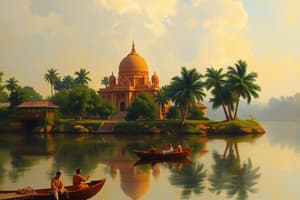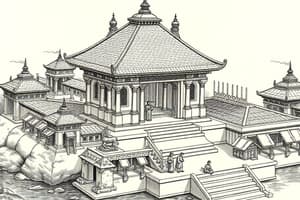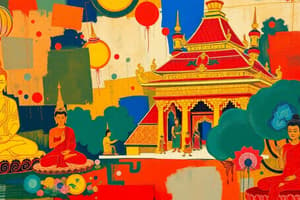Podcast
Questions and Answers
Where was the capital of the Pala Empire initially established by its founder Gopala?
Where was the capital of the Pala Empire initially established by its founder Gopala?
- Kamarupa
- Patna
- Vikramashila
- Gaur (correct)
Which ruler of the Pala Empire is known for extending its boundaries towards Assam and establishing ties with local kingdoms like Kamarupa?
Which ruler of the Pala Empire is known for extending its boundaries towards Assam and establishing ties with local kingdoms like Kamarupa?
- Mahipala I
- Devapala (correct)
- Gopala
- Mahipala II
Which empire defeated Mahipala II, leading to the downfall and fragmentation of the Pala vassals?
Which empire defeated Mahipala II, leading to the downfall and fragmentation of the Pala vassals?
- Chola dynasty
- Karnata dynasty (correct)
- Mughal Empire
- Gupta Empire
Which university is cited as an example of the Pala Empire's patronage of education?
Which university is cited as an example of the Pala Empire's patronage of education?
Where did the Pala Empire's most famous ruler Devapala establish his capital?
Where did the Pala Empire's most famous ruler Devapala establish his capital?
Which region did the Pala Empire not stretch across at its peak under Mahipala I?
Which region did the Pala Empire not stretch across at its peak under Mahipala I?
Where did the principal throne of the Chutiya kingdom lie?
Where did the principal throne of the Chutiya kingdom lie?
Who is credited with the celebrated 'Brahmaputa Purana' in Assamese culture?
Who is credited with the celebrated 'Brahmaputa Purana' in Assamese culture?
During which ruler's reign did the Chutiya kingdom expand considerably into Lower Assam?
During which ruler's reign did the Chutiya kingdom expand considerably into Lower Assam?
Who seized control over territories in southeast Bengal, leading to the fall of the Pala Empire?
Who seized control over territories in southeast Bengal, leading to the fall of the Pala Empire?
Which dynasty emerged amidst the decline of the Pala Empire?
Which dynasty emerged amidst the decline of the Pala Empire?
What factor contributed largely to Assam retaining and reviving its native indigenous religions?
What factor contributed largely to Assam retaining and reviving its native indigenous religions?
Flashcards are hidden until you start studying
Study Notes
The Pala and Chutiya Dynasties: Ruling India's Northeast
From the seventh century CE until around the twelfth century, two dynasties shaped the history of northeastern India – the Pala and Chutiya. These kingdoms wielded significant influence, leaving behind cultural, religious, and architectural legacies that continue to captivate scholars and travelers alike.
The Pala Empire
The Pāla empire originated from the region known today as Bengal. Its founder, Gopala (reigned c. 750 CE), established the dynasty with his capital at Gaur (modern-day West Bengal) before later shifting it to Pataliputra (present-day Patna). The most famous ruler was Devapala (c. 810–ca. 850 CE), who extended the boundaries of the empire towards Assam, establishing close ties with local kingdoms such as Kamarupa.
At its peak under Mahipala I (r. 990–1042 CE), the empire stretched across much of present-day Bihar, Jharkhand, eastern Uttar Pradesh, Odisha, and parts of Bangladesh and Nepal. The Palas were ardent patrons of Buddhism and developed numerous monasteries throughout their realm. Notable examples include Vikramashila University and Somapura Mahavihara, showcasing their prowess in education and architecture respectively.
The downfall began when Mahipala II faced defeat by Vijayashaktigupta, king of the Karnata dynasty, which led to disintegration and fragmentation among Pala vassals. Influential Hindu kings like Kanadeva seized control over territories in southeast Bengal, eventually leading to the fall of the Pala Empire.
The Chutiya Kingdom
Origins tracing back to the sixth century CE, the Cūṭiya kingdom emerged amidst the decline of the Pala Empire. Their principal throne lay within the ancient city of Sadiya, situated near modern Guwahati. Although smaller in size compared to the Palas, this kingdom expanded considerably during the reign of Bhaskara Varman (flourished between 1080 and 1150 CE) into Lower Assam. Moreover, they made impressive contributions to Assamese culture through poetry, music, and art, particularly evident in the celebrated "Brahmaputa Purana," credited to Sarbananda Cūṭīya.
Unlike other neighboring regions where Hinduism rose relatively unchallenged after the demise of Buddhist empires, Assam retained and revived its native indigenous religions, along with vibrant syncretic forms, due largely to the stewardship of the Chutiya kingdom.
In conclusion, the rise and significance of these dynasties illuminate the complexities of early Indian history while highlighting the vital role of regional kingdoms in shaping cultures and societies. Their impact upon India's northeastern frontier remains prominent even today.
Studying That Suits You
Use AI to generate personalized quizzes and flashcards to suit your learning preferences.




